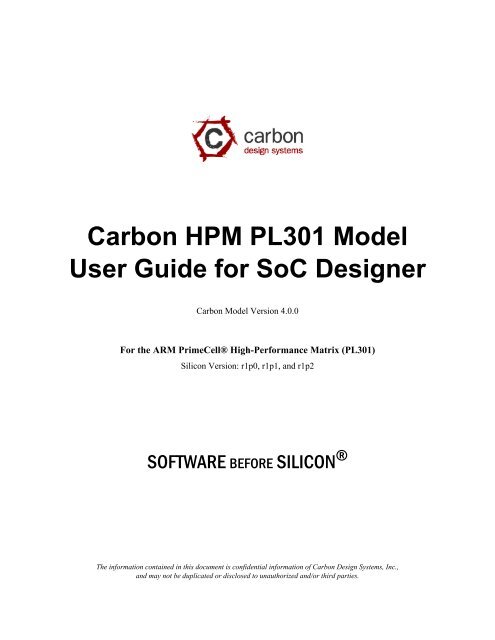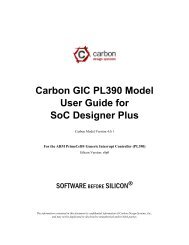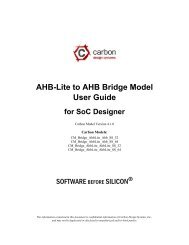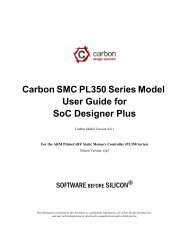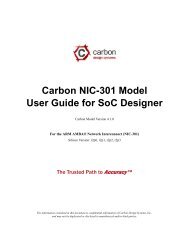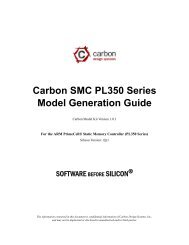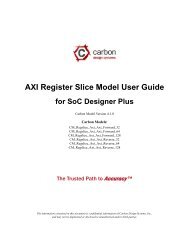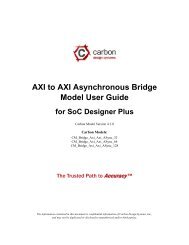Carbon HPM PL301 Model User Guide for SoC Designer
Carbon HPM PL301 Model User Guide for SoC Designer
Carbon HPM PL301 Model User Guide for SoC Designer
You also want an ePaper? Increase the reach of your titles
YUMPU automatically turns print PDFs into web optimized ePapers that Google loves.
<strong>Carbon</strong> <strong>HPM</strong> <strong>PL301</strong> <strong>Model</strong><br />
<strong>User</strong> <strong>Guide</strong> <strong>for</strong> <strong>SoC</strong> <strong>Designer</strong><br />
<strong>Carbon</strong> <strong>Model</strong> Version 4.0.0<br />
For the ARM PrimeCell® High-Per<strong>for</strong>mance Matrix (<strong>PL301</strong>)<br />
Silicon Version: r1p0, r1p1, and r1p2<br />
SOFTWARE BEFORE SILICON ®<br />
The in<strong>for</strong>mation contained in this document is confidential in<strong>for</strong>mation of <strong>Carbon</strong> Design Systems, Inc.,<br />
and may not be duplicated or disclosed to unauthorized and/or third parties.
Copyright<br />
Copyright © 2003-2012 <strong>Carbon</strong> Design Systems, Inc. All rights reserved.<br />
Files, documents or portions thereof presented on the <strong>Carbon</strong> Design Systems Internet server “Publication”, permits persons<br />
to view, copy, and print the Publication subject to the following conditions:<br />
• The Publication are to be kept strictly confidential<br />
• Copies of the Publication will not be distributed<br />
• Copies of the Publication must include the <strong>Carbon</strong> Design Systems copyright notice<br />
• <strong>Carbon</strong> Design Systems logos may only be used with <strong>Carbon</strong>'s expressed written permission, including but not limited<br />
to: linking through hyperlinks, electronic display, and print <strong>for</strong>mat.<br />
Disclaimer of Warranty<br />
This publication is provided “as is” without warranty of any kind, either expressed or implied, including, but not limited<br />
to, the implied warranties of merchantability, fitness <strong>for</strong> a particular purpose, or non-infringement. <strong>Carbon</strong> Design Systems<br />
assumes no responsibility <strong>for</strong> errors or omissions in this publication or other documents which are referenced by or<br />
linked to this publication.<br />
References to corporations, their services and products, are provided “as is” without warranty of any kind, either<br />
expressed or implied. In no event shall <strong>Carbon</strong> Design Systems be liable <strong>for</strong> any special, incidental, indirect or consequential<br />
damages of any kind, or any damages whatsoever, including, without limitation, those resulting from loss of<br />
use, data or profits, whether or not advised of the possibility of damage, and on any theory of liability, arising out of or in<br />
connection with the use or per<strong>for</strong>mance of this in<strong>for</strong>mation.<br />
This publication may include technical or other inaccuracies or typographical errors. <strong>Carbon</strong> Design Systems may make<br />
improvements and/or changes in the product(s) and/or the program(s) described in this publication and in the publication<br />
itself at any time.<br />
Trademarks<br />
© 2003-2012 <strong>Carbon</strong> Design Systems, Inc. All rights reserved. <strong>Carbon</strong> Design Systems, the <strong>Carbon</strong> Design Systems<br />
logo, <strong>Carbon</strong> <strong>Model</strong> Studio, Replay, OnDemand, <strong>SoC</strong> <strong>Designer</strong>, Software Be<strong>for</strong>e Silicon, SOC-VSP, VSP, and The<br />
Answer to Validation are trademarks or registered trademarks of <strong>Carbon</strong> Design Systems, Incorporated in the United<br />
States and/or other countries.<br />
ARM, AMBA and RealView are registered trademarks of ARM Limited. AHB, APB and AXI are trademarks of ARM<br />
Limited. “ARM” is used to represent ARM Holdings plc; its operating company ARM Limited; and the regional subsidiaries<br />
ARM INC.; ARM KK; ARM Korea Ltd.; ARM Taiwan; ARM France SAS; ARM Consulting (Shanghai) Co.<br />
Ltd.; ARM Belgium N.V.; ARM Embedded Technologies Pvt. Ltd.; and ARM Physical IP, Inc.<br />
Microsoft, Windows 2000, and Windows XP are trademarks or registered trademarks of Microsoft Corporation in the<br />
United States and/or other countries.<br />
SystemC is a trademark of the Open SystemC Initiative.<br />
All other trademarks, registered trademarks, and products referenced herein are the property of their respective owners.<br />
<strong>Carbon</strong> Design Systems, Inc. Confidential
Technical Support<br />
If you have questions or problems concerning <strong>Carbon</strong> software, contact Technical Support.<br />
Phone Support Hours: Monday–Friday<br />
9:00 am–5:00 pm EST<br />
<strong>Carbon</strong> Design Systems, Inc.<br />
125 Nagog Park<br />
Acton, MA 01720<br />
Voice: +1-978-264-7399<br />
Asia: +81-3-5524-1288<br />
Fax: +1-978-264-9990<br />
Email: support@carbondesignsystems.com<br />
Web: www.carbondesignsystems.com<br />
Voice mail is available after hours. You may also access our on-line feedback <strong>for</strong>m any time from the Support page of<br />
the <strong>Carbon</strong> web site.<br />
Document revised May 2012.
<strong>Carbon</strong> Design Systems, Inc. Confidential
Contents<br />
Chapter 1.<br />
Using the <strong>Model</strong> Kit Component in <strong>SoC</strong> <strong>Designer</strong><br />
<strong>PL301</strong> <strong>HPM</strong> <strong>Model</strong> Functionality . . . . . . . . . . . . . . . . . . . . . . . . . . . . . . . . . . . . . . . . . . . . .1-1<br />
Implemented Hardware Features . . . . . . . . . . . . . . . . . . . . . . . . . . . . . . . . . . . . . . . . . . .1-2<br />
Differences from the ARM RVML <strong>Model</strong> . . . . . . . . . . . . . . . . . . . . . . . . . . . . . . . . . . .1-3<br />
Adding and Configuring the <strong>SoC</strong> <strong>Designer</strong> Component . . . . . . . . . . . . . . . . . . . . . . . . . . . .1-4<br />
<strong>Carbon</strong> <strong>SoC</strong> <strong>Designer</strong> Component Files . . . . . . . . . . . . . . . . . . . . . . . . . . . . . . . . . . . . .1-4<br />
Adding the <strong>Carbon</strong> <strong>Model</strong> to the Component Library . . . . . . . . . . . . . . . . . . . . . . . . . .1-5<br />
Adding the Component to the <strong>SoC</strong> <strong>Designer</strong> Canvas . . . . . . . . . . . . . . . . . . . . . . . . . . .1-5<br />
Available Component ESL Ports . . . . . . . . . . . . . . . . . . . . . . . . . . . . . . . . . . . . . . . . . . . . . .1-6<br />
Setting Component Parameters . . . . . . . . . . . . . . . . . . . . . . . . . . . . . . . . . . . . . . . . . . . . . . .1-8<br />
Debug Features . . . . . . . . . . . . . . . . . . . . . . . . . . . . . . . . . . . . . . . . . . . . . . . . . . . . . . . . . .1-12<br />
Register In<strong>for</strong>mation . . . . . . . . . . . . . . . . . . . . . . . . . . . . . . . . . . . . . . . . . . . . . . . . . . .1-12<br />
Available Profiling Data . . . . . . . . . . . . . . . . . . . . . . . . . . . . . . . . . . . . . . . . . . . . . . . . . . .1-19<br />
<strong>Carbon</strong> Design Systems, Inc. Confidential
vi<br />
Contents<br />
<strong>Carbon</strong> Design Systems, Inc. Confidential
Preface<br />
A <strong>Carbon</strong> <strong>Model</strong> component is a library developed from ARM intellectual property (IP)<br />
that is generated through <strong>Carbon</strong> <strong>Model</strong> Studio. The model then can be used within a<br />
virtual plat<strong>for</strong>m tool, <strong>for</strong> example, <strong>Carbon</strong> <strong>SoC</strong> <strong>Designer</strong>.<br />
About This <strong>Guide</strong><br />
This guide provides all the in<strong>for</strong>mation needed to configure and use the <strong>Carbon</strong> <strong>PL301</strong><br />
<strong>Model</strong> in <strong>Carbon</strong> <strong>SoC</strong> <strong>Designer</strong>.<br />
Audience<br />
This guide is intended <strong>for</strong> experienced hardware and software developers who create components<br />
<strong>for</strong> use with <strong>Carbon</strong> <strong>SoC</strong> <strong>Designer</strong>. You should be familiar with the following<br />
products and technology:<br />
• <strong>Carbon</strong> <strong>SoC</strong> <strong>Designer</strong><br />
• Hardware design verification<br />
• Verilog or VHDL programming language<br />
<strong>Carbon</strong> Design Systems, Inc. Confidential
viii<br />
Preface<br />
Conventions<br />
This guide uses the following conventions:<br />
Convention Description Example<br />
courier<br />
italic<br />
bold<br />
<br />
Commands, functions,<br />
variables, routines, and<br />
code examples that are set<br />
apart from ordinary text.<br />
New or unusual words or<br />
phrases appearing <strong>for</strong> the<br />
first time.<br />
Action that the user per<strong>for</strong>ms.<br />
Values that you fill in, or<br />
that the system automatically<br />
supplies.<br />
[ text ] Square brackets [ ] indicate<br />
optional text.<br />
[ text1 | text2 ] The vertical bar | indicates<br />
“OR,” meaning that you<br />
can supply text1 or text 2.<br />
sparseMem_t SparseMemCreate-<br />
New();<br />
Transactors provide the entry and exit<br />
points <strong>for</strong> data ...<br />
Click Close to close the dialog.<br />
/ represents the name of<br />
various plat<strong>for</strong>ms.<br />
$CARBON_HOME/bin/modelstudio<br />
[ ]<br />
$CARBON_HOME/bin/modelstudio<br />
[.symtab.db |<br />
.ccfg ]<br />
Also note the following references:<br />
• References to C code implicitly apply to C++ as well.<br />
• File names ending in .cc, .cpp, or .cxx indicate a C++ source file.<br />
<strong>Carbon</strong> Design Systems, Inc. Confidential
Preface<br />
ix<br />
Further reading<br />
This section lists related publications by <strong>Carbon</strong> and by third parties.<br />
<strong>Carbon</strong> <strong>Model</strong> Documentation<br />
The following publications provide in<strong>for</strong>mation that relate directly to models created with<br />
<strong>Carbon</strong> <strong>Model</strong> Studio:<br />
• <strong>Carbon</strong> <strong>HPM</strong> <strong>PL301</strong> <strong>Model</strong> Generation <strong>Guide</strong><br />
• <strong>Carbon</strong> <strong>Model</strong> Installation and Licensing <strong>Guide</strong><br />
<strong>Carbon</strong> <strong>SoC</strong> <strong>Designer</strong> Documentation<br />
The following publications provide in<strong>for</strong>mation that relate directly to <strong>SoC</strong> <strong>Designer</strong>:<br />
• <strong>Carbon</strong> <strong>SoC</strong> <strong>Designer</strong> Installation <strong>Guide</strong><br />
• <strong>Carbon</strong> <strong>SoC</strong> <strong>Designer</strong> Migration <strong>Guide</strong><br />
• <strong>Carbon</strong> <strong>SoC</strong> <strong>Designer</strong> <strong>User</strong> <strong>Guide</strong><br />
• <strong>Carbon</strong> <strong>SoC</strong> <strong>Designer</strong> RTOE <strong>User</strong> <strong>Guide</strong><br />
• <strong>Carbon</strong> <strong>SoC</strong> <strong>Designer</strong> <strong>Model</strong>s Reference<br />
• <strong>Carbon</strong> <strong>SoC</strong> <strong>Designer</strong> AHBv2 Protocol Bundle <strong>User</strong> <strong>Guide</strong><br />
External publications<br />
The following publications provide reference in<strong>for</strong>mation about ARM® products:<br />
• ARM PrimeCell High-Per<strong>for</strong>mance Matrix (<strong>PL301</strong>) Technical Summary<br />
• ARM PrimeCell High-Per<strong>for</strong>mance Matrix (<strong>PL301</strong>) Technical Reference Manual<br />
• ARM PrimeCell High-Per<strong>for</strong>mance Matrix (<strong>PL301</strong>) Integration Manual<br />
• AMBA <strong>Designer</strong> (FD001) <strong>User</strong> <strong>Guide</strong><br />
• AMBA <strong>Designer</strong> (FD001) PrimeCell High-Per<strong>for</strong>mance Matrix (<strong>PL301</strong>) <strong>User</strong> <strong>Guide</strong><br />
Supplement<br />
• AMBA Specification<br />
• AMBA AHB Transaction Level <strong>Model</strong>ing Specification<br />
• AMBA AXI Transaction Level <strong>Model</strong>ing Specification<br />
• AMBA 3 APB Protocol Specification<br />
• Architecture Reference Manual<br />
• ARM RealView <strong>Model</strong> Debugger <strong>User</strong> <strong>Guide</strong><br />
See http://infocenter.arm.com/help/index.jsp <strong>for</strong> access to ARM documentation.<br />
The following publications provide additional in<strong>for</strong>mation on simulation:<br />
• IEEE 1666 SystemC Language Reference Manual, (IEEE Standards Association)<br />
• SPIRIT <strong>User</strong> <strong>Guide</strong>, Revision 1.2, SPIRIT Consortium.<br />
<strong>Carbon</strong> Design Systems, Inc. Confidential
x<br />
Preface<br />
Glossary<br />
AMBA<br />
AHB<br />
APB<br />
AXI<br />
<strong>Carbon</strong> <strong>Model</strong><br />
<strong>Carbon</strong> <strong>Model</strong><br />
Studio<br />
CASI<br />
CADI<br />
CAPI<br />
Component<br />
ESL<br />
HDL<br />
RTL<br />
<strong>SoC</strong> <strong>Designer</strong><br />
SystemC<br />
Transactor<br />
Advanced Microcontroller Bus Architecture. The ARM open standard on-chip<br />
bus specification that describes a strategy <strong>for</strong> the interconnection and management<br />
of functional blocks that make up a System-on-Chip (<strong>SoC</strong>).<br />
Advanced High-per<strong>for</strong>mance Bus. A bus protocol with a fixed pipeline<br />
between address/control and data phases. It only supports a subset of the functionality<br />
provided by the AMBA AXI protocol.<br />
Advanced Peripheral Bus. A simpler bus protocol than AXI and AHB. It is<br />
designed <strong>for</strong> use with ancillary or general-purpose peripherals such as timers,<br />
interrupt controllers, UARTs, and I/O ports.<br />
Advanced eXtensible Interface. A bus protocol that is targeted at high per<strong>for</strong>mance,<br />
high clock frequency system designs and includes a number of features<br />
that make it very suitable <strong>for</strong> high speed sub-micron interconnect.<br />
A software object created by the <strong>Carbon</strong> <strong>Model</strong> Studio (or <strong>Carbon</strong> compiler)<br />
from an RTL design. The <strong>Carbon</strong> <strong>Model</strong> contains a cycle- and register-accurate<br />
model of the hardware design.<br />
<strong>Carbon</strong>’s graphical tool <strong>for</strong> generating, validating, and executing hardwareaccurate<br />
software models. It creates a <strong>Carbon</strong> <strong>Model</strong>, and it also takes a <strong>Carbon</strong><br />
<strong>Model</strong> as input and generates a <strong>Carbon</strong> component that can be used in<br />
<strong>SoC</strong> <strong>Designer</strong>, Plat<strong>for</strong>m Architect, or OSCI SystemC <strong>for</strong> simulation.<br />
ESL API Simulation Interface, is based on the SystemC communication<br />
library and manages the interconnection of components and communication<br />
between components.<br />
ESL API Debug Interface, enables reading and writing memory and register<br />
values and also provides the interface to external debuggers.<br />
ESL API Profiling Interface, enables collecting historical data from a component<br />
and displaying the results in various <strong>for</strong>mats.<br />
Building blocks used to create simulated systems. Components are connected<br />
together with unidirectional transaction-level or signal-level connections.<br />
Electronic System Level. A type of design and verification methodology that<br />
models the behavior of an entire system using a high-level language such as C<br />
or C++.<br />
Hardware Description Language. A language <strong>for</strong> <strong>for</strong>mal description of electronic<br />
circuits, <strong>for</strong> example, Verilog or VHDL.<br />
Register Transfer Level. A high-level hardware description language (HDL)<br />
<strong>for</strong> defining digital circuits.<br />
The full name is <strong>Carbon</strong> <strong>SoC</strong> <strong>Designer</strong>. A high-per<strong>for</strong>mance, cycle accurate<br />
simulation framework which is targeted at System-on-a-Chip hardware and<br />
software debug as well as architectural exploration.<br />
SystemC is a single, unified design and verification language that enables verification<br />
at the system level, independent of any detailed hardware and software<br />
implementation, as well as enabling co-verification with RTL design.<br />
Transaction adaptors. You add transactors to your <strong>Carbon</strong> component to connect<br />
your component directly to transaction level interface ports <strong>for</strong> your particular<br />
plat<strong>for</strong>m.<br />
<strong>Carbon</strong> Design Systems, Inc. Confidential
Chapter 1<br />
Using the <strong>Model</strong> Kit Component in <strong>SoC</strong> <strong>Designer</strong><br />
This chapter describes the functionality of the <strong>Model</strong> component, and how to use it in <strong>Carbon</strong><br />
<strong>SoC</strong> <strong>Designer</strong>. It contains the following sections:<br />
• <strong>PL301</strong> <strong>HPM</strong> <strong>Model</strong> Functionality<br />
• Adding and Configuring the <strong>SoC</strong> <strong>Designer</strong> Component<br />
• Available Component ESL Ports<br />
• Setting Component Parameters<br />
• Debug Features<br />
• Available Profiling Data<br />
Note:<br />
If you received the <strong>Model</strong> from <strong>Carbon</strong>, see the provided “<strong>Carbon</strong> <strong>Model</strong> Installation<br />
and Licensing <strong>Guide</strong>” <strong>for</strong> <strong>Model</strong> installation and licensing in<strong>for</strong>mation.<br />
1.1 <strong>PL301</strong> <strong>HPM</strong> <strong>Model</strong> Functionality<br />
The <strong>HPM</strong> is a highly configurable auto-generated AMBA 3 bus subsystem, based around<br />
a high-per<strong>for</strong>mance AXI cross-bar switch known as the AXI bus matrix, and extended by<br />
AMBA infrastructure components. For in<strong>for</strong>mation about these components, see the ARM<br />
PrimeCell High-Per<strong>for</strong>mance Matrix (<strong>PL301</strong>) Technical Reference Manual.<br />
This combination of IP provides support <strong>for</strong> other AMBA interface protocols, including<br />
AHB-Lite and APB.<br />
Use the AMBA <strong>Designer</strong> Graphical <strong>User</strong> Interface configuration tool to design your bus<br />
matrix. You can then generate, test, and profile complex AMBA bus systems in:<br />
• a transaction-level modeling environment<br />
• Verilog<br />
This section provides a summary of the functionality of the model compared to that of the<br />
hardware, and the per<strong>for</strong>mance and accuracy of the model.<br />
• Implemented Hardware Features<br />
• Differences from the ARM RVML <strong>Model</strong><br />
<strong>Carbon</strong> Design Systems, Inc. Confidential
1-2 Using the <strong>Model</strong> Kit Component in <strong>SoC</strong> <strong>Designer</strong><br />
1.1.1 Implemented Hardware Features<br />
The <strong>PL301</strong> <strong>HPM</strong> has:<br />
• configurable number of slave interfaces (SIs) and master interfaces (MIs)<br />
• multi-layer AXI routing, suitable <strong>for</strong> high-per<strong>for</strong>mance applications<br />
• sparse connection options to reduce gate count and improve security<br />
• configurable AXI data widths<br />
• configurable AHB-Lite data widths<br />
• configurable address widths on AXI and AHB-Lite interfaces<br />
• support <strong>for</strong> an AHB-Lite to AXI bridge optimized <strong>for</strong> use with memory controllers<br />
• support <strong>for</strong> AMBA 2 APB and AMBA 3 APB at 32-bit data width<br />
• decoded address register that you can configure <strong>for</strong> each SI<br />
• flexible register stages to aid timing closure<br />
• an arbitration mechanism that you can configure (in AMBA <strong>Designer</strong>) <strong>for</strong> each MI,<br />
implementing:<br />
– a fixed Round-Robin (RR) scheme<br />
– a programmable RR scheme<br />
– a programmable scheme that provides prioritized groups of Least Recently<br />
Granted (LRG) arbitration<br />
• a programmable Quality of Service (QoS) scheme<br />
• an APB interface to provide access to programming registers<br />
• support <strong>for</strong> multiple clock domains:<br />
– synchronous<br />
– asynchronous<br />
• configurable cyclic dependency schemes to enable a master to have outstanding transactions<br />
to more than one slave<br />
• PrimeCell ID register to aid self-discovery in systems<br />
• a configurable memory map<br />
• support <strong>for</strong> TrustZone® technology<br />
• AXI and AHB USER signal support<br />
• auto-generated Verilog<br />
• auto-generated RTL testbench<br />
• AMBA <strong>Designer</strong> tool-based configuration<br />
<strong>Carbon</strong> Design Systems, Inc. Confidential
<strong>PL301</strong> <strong>HPM</strong> <strong>Model</strong> Functionality 1-3<br />
1.1.2 Differences from the ARM RVML <strong>Model</strong><br />
The following differences exist between the <strong>Carbon</strong> <strong>Model</strong> and the older ARM® Real-<br />
View® <strong>Model</strong> Library model:<br />
• Appendix A of the ARM PrimeCell High-Per<strong>for</strong>mance Matrix (<strong>PL301</strong>) Technical Reference<br />
Manual lists differences between the RVML <strong>Model</strong> and the actual Register<br />
Transfer Language (RTL). In all cases, the <strong>Carbon</strong> <strong>Model</strong> follows the RTL implementation,<br />
not the RVML implementation.<br />
• The MemMap button of <strong>SoC</strong> <strong>Designer</strong> will bring up a display of the memory maps<br />
that are defined within any <strong>PL301</strong> components in the current system. Note that this<br />
data is read-only.<br />
• If there are any conflicts between defined memory map locations on the <strong>PL301</strong> and a<br />
memory map defined on a connected slave component, a warning message will be<br />
printed, and the <strong>PL301</strong> memory map will be used. The <strong>PL301</strong> memory map is defined<br />
using AMBA <strong>Designer</strong>.<br />
• Only the top component of the <strong>PL301</strong> is visible in the <strong>Carbon</strong> <strong>Model</strong> - subcomponents<br />
are not visible.<br />
<strong>Carbon</strong> Design Systems, Inc. Confidential
1-4 Using the <strong>Model</strong> Kit Component in <strong>SoC</strong> <strong>Designer</strong><br />
1.2 Adding and Configuring the <strong>SoC</strong> <strong>Designer</strong> Component<br />
The following topics briefly describe how to use the component. See the <strong>Carbon</strong> <strong>SoC</strong><br />
<strong>Designer</strong> <strong>User</strong> <strong>Guide</strong> <strong>for</strong> more in<strong>for</strong>mation.<br />
• <strong>Carbon</strong> <strong>SoC</strong> <strong>Designer</strong> Component Files<br />
• Adding the <strong>Carbon</strong> <strong>Model</strong> to the Component Library<br />
• Adding the Component to the <strong>SoC</strong> <strong>Designer</strong> Canvas<br />
1.2.1 <strong>Carbon</strong> <strong>SoC</strong> <strong>Designer</strong> Component Files<br />
The component files are the final output from the <strong>Carbon</strong> <strong>Model</strong> Studio compile and are<br />
the input to <strong>SoC</strong> <strong>Designer</strong>. There are two versions of the component; an optimized release<br />
version <strong>for</strong> normal operation, and a debug version.<br />
On Linux the debug version of the component is compiled without optimizations and<br />
includes debug symbols <strong>for</strong> use with gdb. The release version is compiled without debug<br />
in<strong>for</strong>mation and is optimized <strong>for</strong> per<strong>for</strong>mance.<br />
On Windows the debug version of the component is compiled referencing the debug runtime<br />
libraries, so it can be linked with the debug version of <strong>SoC</strong> <strong>Designer</strong>. The release version<br />
is compiled referencing the release runtime library. Both release and debug versions<br />
generate debug symbols <strong>for</strong> use with the Visual C++ debugger on Windows.<br />
The provided component files are listed below:<br />
Table 1-1 <strong>Carbon</strong> <strong>SoC</strong> <strong>Designer</strong> Component Files<br />
Plat<strong>for</strong>m File Description<br />
Linux<br />
Windows<br />
maxlib.lib.conf<br />
lib.mx.so<br />
lib.mx_DBG.so<br />
maxlib.lib.windows.conf<br />
lib.mx.dll<br />
lib.mx_DBG.dll<br />
<strong>SoC</strong> <strong>Designer</strong> configuration file<br />
<strong>SoC</strong> <strong>Designer</strong> component runtime file<br />
<strong>SoC</strong> <strong>Designer</strong> component debug file<br />
<strong>SoC</strong> <strong>Designer</strong> configuration file<br />
<strong>SoC</strong> <strong>Designer</strong> component runtime file<br />
<strong>SoC</strong> <strong>Designer</strong> component debug file<br />
Additionally, this <strong>User</strong> <strong>Guide</strong> PDF file, the <strong>Carbon</strong> <strong>Model</strong> Installation and Licensing<br />
<strong>Guide</strong>, and a ReadMe text file are provided with the component.<br />
Note:<br />
If you generated these files from a <strong>Carbon</strong> <strong>Model</strong> Kit, they are located in<br />
/data/<strong>SoC</strong><strong>Designer</strong>. If you installed them from a model package from<br />
<strong>Carbon</strong> Design Systems, they are located where you instructed the installer to<br />
place them.<br />
<strong>Carbon</strong> Design Systems, Inc. Confidential
Adding and Configuring the <strong>SoC</strong> <strong>Designer</strong> Component 1-5<br />
1.2.2 Adding the <strong>Carbon</strong> <strong>Model</strong> to the Component Library<br />
The compiled <strong>Carbon</strong> <strong>Model</strong> component is provided as a configuration file (.conf). To<br />
make the component available in the Component Window in <strong>SoC</strong> <strong>Designer</strong> Canvas, per<strong>for</strong>m<br />
the following steps:<br />
1. Launch <strong>SoC</strong> <strong>Designer</strong> Canvas.<br />
2. From the File menu, select Preferences.<br />
3. Click on Component Library in the list on the left.<br />
4. Under the Additional Component Configuration Files window, click Add.<br />
5. Browse to the location where the <strong>SoC</strong> <strong>Designer</strong> model is located and select the component<br />
configuration file:<br />
– maxlib.lib.conf (<strong>for</strong> Linux)<br />
– maxlib.lib.windows.conf (<strong>for</strong> Windows)<br />
6. Click OK.<br />
7. To save the preferences permanently, click the OK & Save button.<br />
The component is now available from the <strong>SoC</strong> <strong>Designer</strong> Component Window.<br />
1.2.3 Adding the Component to the <strong>SoC</strong> <strong>Designer</strong> Canvas<br />
Locate the component in the Component Window and drag it out to the Canvas. It will<br />
appear as shown in Figure 1-1.<br />
AXI<br />
AHB<br />
APB<br />
Figure 1-1 <strong>PL301</strong> High-Per<strong>for</strong>mance Matrix Components in <strong>SoC</strong> <strong>Designer</strong><br />
<strong>Carbon</strong> Design Systems, Inc. Confidential
1-6 Using the <strong>Model</strong> Kit Component in <strong>SoC</strong> <strong>Designer</strong><br />
This figure shows three different components in order to show a variety of available ports.<br />
The AXI component includes two interface master ports and two interface slave ports. The<br />
AHB component includes two interface master ports and one interface slave port. The<br />
APB component includes two interface master ports and one interface slave port. Your<br />
component may appear with fewer or more ports, depending on how it was configured in<br />
AMBA <strong>Designer</strong>.<br />
Additionally, the port names shown are AMBA <strong>Designer</strong> default names. Depending on the<br />
configuration in AMBA <strong>Designer</strong> the default port names may be different. Also, you can<br />
override the default names in AMBA <strong>Designer</strong> so that the names are fully customizable.<br />
This naming distinction determines the ESL port names and the component parameter<br />
names used in this manual.<br />
1.3 Available Component ESL Ports<br />
Table 1-2 describes the ESL ports of the component, created by AMBA <strong>Designer</strong>, that are<br />
exposed in <strong>SoC</strong> <strong>Designer</strong>. See the AMBA <strong>Designer</strong> (FD001) <strong>User</strong> <strong>Guide</strong> Supplement <strong>for</strong><br />
the <strong>PL301</strong>. See also the ARM PrimeCell High Per<strong>for</strong>mance Matrix (<strong>PL301</strong>) Integration<br />
Manual <strong>for</strong> more in<strong>for</strong>mation.<br />
Many ports in the table use the naming <strong>for</strong>mat [m/s] , where the<br />
protocol type is part of the name. For example, s00_axi_64, m01_apb_32,<br />
PCLKENm00_apb_32, etc.<br />
Table 1-2 ESL Component Ports<br />
ESL Port Description Direction Type<br />
APB_in<br />
The APB interface created by AMBA<br />
<strong>Designer</strong>.<br />
input<br />
APB transaction<br />
slave<br />
PCLK<br />
Clock <strong>for</strong> the APB programming interface.<br />
This clock must be synchronous to CLK.<br />
input<br />
Clock slave<br />
PCLKEN<br />
The Clock enable signal <strong>for</strong> the APB interface<br />
named .<br />
input<br />
signal<br />
PRESETn<br />
APB reset signal. The reset signal is:<br />
input<br />
Signal slave<br />
– asserted asynchronously<br />
– de-asserted synchronously to the rising<br />
edge of PCLK.<br />
PSELEN<br />
The SEL enable signal <strong>for</strong> the APB interface<br />
named .<br />
input<br />
Signal slave<br />
REMAP<br />
This vector is added by AMBA <strong>Designer</strong><br />
when a memory map is defined.<br />
input<br />
Signal slave<br />
RESETn 1<br />
AXI reset signal. The reset signal is:<br />
– asserted asynchronously<br />
– de-asserted synchronously to the rising<br />
edge of CLK.<br />
input<br />
Signal slave<br />
<strong>Carbon</strong> Design Systems, Inc. Confidential
Available Component ESL Ports 1-7<br />
CLK<br />
CLK<br />
CLKEN<br />
RESETn 1<br />
TZPCDECPROT0 <br />
AXI core clock. A clock port is created <strong>for</strong><br />
each clock input in a multiple clock<br />
domain.<br />
See the AMBA <strong>Designer</strong> <strong>User</strong> <strong>Guide</strong> Supplement<br />
<strong>for</strong> the <strong>PL301</strong> <strong>for</strong> in<strong>for</strong>mation<br />
about using multiple clock domains.<br />
Additional clock signal if your configuration<br />
contains frequency conversion AXI<br />
infrastructure components, <strong>for</strong> example, a<br />
downward-synchronizing bridge.<br />
Additional clock enable signal if your configuration<br />
contains frequency conversion<br />
AXI infrastructure components, <strong>for</strong> example,<br />
a downward-synchronizing bridge.<br />
Additional reset signal if your configuration<br />
contains frequency conversion AXI<br />
infrastructure components, <strong>for</strong> example, a<br />
downward-synchronizing bridge.<br />
TrustZone security programming registers<br />
<strong>for</strong> APB peripherals 0-7.<br />
input<br />
slave/master<br />
slave/master<br />
slave/master<br />
input<br />
Clock slave<br />
signal<br />
signal<br />
signal<br />
Signal slave<br />
TZPCDECPROT1 TrustZone security programming registers input Signal slave<br />
<strong>for</strong> APB peripherals 8-15.<br />
TZPROT Global bus <strong>for</strong> TrustZone control. input Signal slave<br />
SYNCMODEREQ <br />
Protocol Type Slave Ports<br />
clk-in<br />
Protocol Type Master Ports<br />
Table 1-2 ESL Component Ports (Continued)<br />
ESL Port Description Direction Type<br />
SYNCMODEACK <br />
Synchronous bypass mode request. Only<br />
appears if the master port is defined as<br />
asynchronous (Async).<br />
There is a slave port created <strong>for</strong> each port<br />
defined in AMBA <strong>Designer</strong>. For example,<br />
s00_axi_32, s01_axi_64, etc.<br />
Input clock. When using the CLK port, the<br />
clk-in port should not be connected.<br />
There is a master port created <strong>for</strong> each port<br />
defined in AMBA <strong>Designer</strong>. For example,<br />
m00_axi_64, m01_apb_32, m00_ahb_54,<br />
etc.<br />
Synchronous bypass mode acknowledge.<br />
Only appears if the master port is defined<br />
as asynchronous (Async).<br />
input<br />
slave<br />
slave<br />
master<br />
output<br />
Signal slave<br />
AXI,<br />
AHB_LITE,<br />
APB<br />
Clock slave<br />
AXI,<br />
AHB_LITE,<br />
APB<br />
Signal master<br />
1. The RESETn signal is active low input. If it is left unconnected, then it will be driven to a 1 (the non-resetvalue).<br />
All pins that are not listed in this table have been either tied or disconnected <strong>for</strong> per<strong>for</strong>mance<br />
reasons.<br />
<strong>Carbon</strong> Design Systems, Inc. Confidential
1-8 Using the <strong>Model</strong> Kit Component in <strong>SoC</strong> <strong>Designer</strong><br />
Note:<br />
Some ESL component port values can be set using a component parameter. This<br />
includes the RESETn, PRESETn, PSELEN, PCLKEN, TZPCDECPROT0, and<br />
TZPCDECPROT1 ports. In those cases, the parameter value will be used whenever<br />
the ESL port is not connected. If the port is connected, the connection value<br />
takes precedence over the parameter value.<br />
1.4 Setting Component Parameters<br />
You can change the settings of all the component parameters in <strong>SoC</strong> <strong>Designer</strong> Canvas, and<br />
of some of the parameters in <strong>SoC</strong> <strong>Designer</strong> Simulator. To modify the <strong>Carbon</strong> component’s<br />
parameters:<br />
1. In the Canvas, right-click on the <strong>Carbon</strong> component and select Edit Parameters....<br />
You can also double-click the component. The Edit Parameters dialog box appears.<br />
Figure 1-2 Component Parameters Dialog Box<br />
2. In the Parameters window, double-click the Value field of the parameter that you<br />
want to modify.<br />
3. If it is a text field, type a new value in the Value field. If a menu choice is offered,<br />
select the desired option. The parameters are described in Table 1-3.<br />
<strong>Carbon</strong> Design Systems, Inc. Confidential
Setting Component Parameters 1-9<br />
Table 1-3 Component Parameters<br />
Name<br />
Description<br />
Allowed<br />
Values<br />
Default Value Runtime 1<br />
APB_in Base Address Base address 0x0 - 0xffffffff 0x0 No<br />
APB_in Enable Debug<br />
Messages<br />
Whether debug messages are<br />
logged <strong>for</strong> the APB_in port.<br />
true, false false Yes<br />
APB_in Size Size 0x0 -<br />
0x100000000 No<br />
0x100000000<br />
Align Wave<strong>for</strong>ms When set to true, wave<strong>for</strong>ms<br />
dumped from the <strong>Carbon</strong> component<br />
are aligned with the <strong>SoC</strong><br />
<strong>Designer</strong> simulation time. The<br />
reset sequence, however, is not<br />
included in the dumped data.<br />
When set to false, the reset<br />
sequence is dumped to the wave<strong>for</strong>m<br />
data, however, the <strong>Carbon</strong><br />
component time is not aligned<br />
with the <strong>SoC</strong> <strong>Designer</strong> time.<br />
true, false true No<br />
<strong>Carbon</strong> DB Path<br />
Dump Wave<strong>for</strong>ms<br />
Enable Debug Messages<br />
Align<br />
Data<br />
Big<br />
Endian<br />
Enable<br />
Debug Messages<br />
PReady<br />
Default High<br />
PCLKEN<br />
Sets the directory path to the <strong>Carbon</strong><br />
database file.<br />
Whether <strong>SoC</strong> <strong>Designer</strong> dumps<br />
wave<strong>for</strong>ms <strong>for</strong> this component.<br />
Whether debug messages are<br />
logged <strong>for</strong> the component.<br />
Whether halfword and byte transactions<br />
will align data to the transaction<br />
size <strong>for</strong> the master ports. By<br />
default, data is not aligned.<br />
Whether AHB data is treated as<br />
big endian <strong>for</strong> the master ports. By<br />
default, data is not sent as big<br />
endian.<br />
Whether debug messages are<br />
logged <strong>for</strong> the master ports. There<br />
is one parameter <strong>for</strong> each master<br />
port.<br />
The transfer is extended if<br />
PREADY is held low during an<br />
access phase. There is one parameter<br />
<strong>for</strong> each master port.<br />
Default value <strong>for</strong><br />
PCLKEN.<br />
Not Used empty No<br />
true, false false Yes<br />
true, false false Yes<br />
true, false false No<br />
true, false false No<br />
true, false false Yes<br />
true, false true Yes<br />
0, 1 1 Yes<br />
<strong>Carbon</strong> Design Systems, Inc. Confidential
1-10 Using the <strong>Model</strong> Kit Component in <strong>SoC</strong> <strong>Designer</strong><br />
Table 1-3 Component Parameters (Continued)<br />
Name<br />
Description<br />
Allowed<br />
Values<br />
Default Value Runtime 1<br />
PRESETn<br />
PSELEN<br />
RESETn<br />
TZPCDECPROT0<br />
<br />
TZPCDECPROT1<br />
<br />
Default value <strong>for</strong> PRESET - active<br />
high or active low.<br />
Default value <strong>for</strong><br />
PSELEN. Low indicates<br />
absence of an APB device in<br />
that slot. High indicates that an<br />
APB slave device exists in that<br />
slot.<br />
Default value <strong>for</strong> RESET - active<br />
high or active low.<br />
Default value <strong>for</strong><br />
TZPCDECPROT0.<br />
Low indicates that all AXI access<br />
to that APB peripheral must be<br />
secure. High indicates that access<br />
can be secure or non-secure.<br />
Default value <strong>for</strong><br />
TZPCDECPROT1.<br />
Low indicates that all AXI access<br />
to that APB peripheral must be<br />
secure. High indicates that access<br />
can be secure or non-secure.<br />
s0[0-1]_ Sizes of memory regions. 0x0 -<br />
axi_size[0-5] 2 0x100000000<br />
0x0, 0x1 0x1 Yes<br />
0x0 - 0xFFFF 0xFFFF Yes<br />
0x0, 0x1 0x1 Yes<br />
0x0 - 0xFF 0 Yes<br />
0x0 - 0xFF 0 Yes<br />
size0 default is<br />
0x100000000,<br />
size1-5 default<br />
is 0<br />
s0[0-1]_ Start addresses of memory regions. 0x0 - 0xffffffff 0x00000000 No<br />
axi_start[0-5] 2<br />
ahbm<br />
port ID<br />
Align<br />
Data<br />
Big<br />
Endian<br />
Enable<br />
Debug Messages<br />
ID of the slave port. value 0 No<br />
Whether halfword and byte transactions<br />
will align data to the transaction<br />
size <strong>for</strong> the slave ports. By<br />
default, data is not aligned.<br />
Whether AHB data is treated as<br />
big endian <strong>for</strong> the slave ports. By<br />
default, data is not sent as big<br />
endian.<br />
Whether debug messages are<br />
logged <strong>for</strong> slave ports. There is one<br />
parameter <strong>for</strong> each slave port.<br />
No<br />
true, false false No<br />
true, false false No<br />
true, false false Yes<br />
<strong>Carbon</strong> Design Systems, Inc. Confidential
Setting Component Parameters 1-11<br />
Table 1-3 Component Parameters (Continued)<br />
Name<br />
Description<br />
Allowed<br />
Values<br />
Default Value Runtime 1<br />
region<br />
size [0-5]<br />
region<br />
start [0-5]<br />
size 0 is the size of the region<br />
occupied by this AHB slave.<br />
size 1 - size 5 are unused.<br />
start 0 is the base address of the<br />
memory region occupied by this<br />
AHB slave.<br />
start 1 - start 5 are unused.<br />
0x0 -<br />
0x100000000<br />
size 0 default is<br />
0x100000000,<br />
size1-5 default<br />
is 0x0<br />
No<br />
0x0 - 0xffffffff 0x0 No<br />
Wave<strong>for</strong>m File 3 Name of the wave<strong>for</strong>m file. string carbon_pl301_<br />
.vcd<br />
Wave<strong>for</strong>m Timescale<br />
Sets the timescale to be used in the<br />
wave<strong>for</strong>m.<br />
Many values in<br />
drop-down<br />
No<br />
1 ns No<br />
1. Yes means the parameter can be dynamically changed during simulation, No means it can be changed only<br />
when building the system, Reset means it can be changed during simulation, but its new value will be taken<br />
into account only at the next reset.<br />
2. The square brackets used in parameter names specify a range of numbers that are available <strong>for</strong> the model.<br />
The parameter name <strong>for</strong> the start addresses “s0[0-1]_axi_64 axi_start[0-5]” <strong>for</strong> example will be expanded to<br />
12 possible parameter name combinations that range from “s00_axi_64 axi_start0” to “s01_axi_64<br />
axi_start5”. The size of a memory region depends on the “s[N]_axi_64 axi_start[M]” and “s[N]_axi_64<br />
axi_size[M]” parameters. The end address is calculated as StartAddr +Size -1. The size of the memory<br />
region must not exceed the value of 0x100000000. If the sum of StartAddr+Size is greater than<br />
0x100000000, the size of the memory region is reduced to the difference: 0x100000000-StartAddr.<br />
3. When enabled, <strong>SoC</strong> <strong>Designer</strong> writes accumulated wave<strong>for</strong>ms to the wave<strong>for</strong>m file in the following situations:<br />
when the wave<strong>for</strong>m buffer fills, when validation is paused and when validation finishes, and at the end<br />
of each validation run.<br />
<strong>Carbon</strong> Design Systems, Inc. Confidential
1-12 Using the <strong>Model</strong> Kit Component in <strong>SoC</strong> <strong>Designer</strong><br />
1.5 Debug Features<br />
The <strong>PL301</strong> model has a debug interface (CADI) that allows the user to view, manipulate,<br />
and control the registers and memory. A view can be accessed in <strong>SoC</strong> <strong>Designer</strong> by right<br />
clicking on the model and choosing the appropriate menu entry.<br />
1.5.1 Register In<strong>for</strong>mation<br />
Figure 2-3 shows the Register view of the <strong>PL301</strong> model in <strong>SoC</strong> <strong>Designer</strong> Simulator.<br />
Figure 1-3 <strong>PL301</strong> Registers View<br />
The <strong>PL301</strong> model has a minimum of three sets of registers that are accessible via the<br />
debug interface.<br />
• For each slave port that is defined in the model, there is one register tab that can be<br />
used to track signals (<strong>for</strong> example, s00_axi_64_sig).<br />
• For each master port defined in the model, there are two register tabs that can be used<br />
to track signals and registers (<strong>for</strong> example, m00_axi_64_sig and m00_axi_64_reg,<br />
respectively).<br />
• The APB_in signals are available in one register tab.<br />
The registers are grouped into sets according to slave and master ports. The registers are<br />
listed below:<br />
• Slave Port Signals Registers<br />
• Master Port Quality of Service Registers<br />
• Master Port Signals Registers<br />
• APB_in Signal Registers<br />
<strong>Carbon</strong> Design Systems, Inc. Confidential
Debug Features 1-13<br />
1.5.1.1 Slave Port Signals Registers<br />
The Slave Port Signals group contains a list of slave port signals and their current values.<br />
There is one register tab <strong>for</strong> each slave port that is part of your component. Slave signals<br />
<strong>for</strong> AXI and AHB are listed in separate tables below.<br />
Table 1-4 shows the AXI slave port signals. See the ARM AMBA AXI Protocol Specification<br />
<strong>for</strong> more in<strong>for</strong>mation about these signals.<br />
Table 1-4 AXI Slave Port Signal Registers<br />
Name Description Type<br />
ARID The read address ID. read-only<br />
ARADDR The read address. read-only<br />
ARVALID Indicates whether the read address is available. read-only<br />
ARREADY Indicates whether the slave is ready to accept the read address. read-only<br />
ARLEN The burst length. read-only<br />
ARSIZE The burst size. read-only<br />
ARBURST The burst type. read-only<br />
ARLOCK The lock type. read-only<br />
ARCACHE The cache type. read-only<br />
ARPROT The protection type. read-only<br />
AWID The write address ID. read-only<br />
AWADDR The write address. read-only<br />
AWVALID Indicates whether the write address is available. read-only<br />
AWREADY Indicates whether the slave is ready to accept the write address. read-only<br />
AWLEN The burst length. read-only<br />
AWSIZE The burst size. read-only<br />
AWBURST The burst type. read-only<br />
AWLOCK The lock type. read-only<br />
AWCACHE The cache type. read-only<br />
AWPROT The protection type. read-only<br />
WID The write ID tag. read-only<br />
WDATA The write data. read-only<br />
WSTRB The write strobes. read-only<br />
WLAST The last transfer in a write burst. read-only<br />
WVALID Indicates whether the write data and strobes are available. read-only<br />
WREADY Indicates whether the slave is ready to accept the write data. read-only<br />
RID The read ID tag. read-only<br />
RDATA The read data. read-only<br />
<strong>Carbon</strong> Design Systems, Inc. Confidential
1-14 Using the <strong>Model</strong> Kit Component in <strong>SoC</strong> <strong>Designer</strong><br />
Table 1-4 AXI Slave Port Signal Registers (Continued)<br />
RLAST The last transfer in a read burst. read-only<br />
RVALID Indicates whether the read data is available. read-only<br />
RREADY Indicates whether the master is ready to accept the read data read-only<br />
and response in<strong>for</strong>mation.<br />
RRESP The read response. read-only<br />
BID The response ID. read-only<br />
BRESP The write response. read-only<br />
BVALID Indicates whether the write response is available. read-only<br />
BREADY Indicates whether the master is ready to accept the response<br />
in<strong>for</strong>mation.<br />
read-only<br />
Table 1-5 shows the AHB slave port signals. See the ARM AMBA AHB Protocol Specification<br />
<strong>for</strong> more in<strong>for</strong>mation about these signals.<br />
Table 1-5 AHB Slave Port Signal Registers<br />
Name Description Type<br />
HADDR The 32-bit system address bus. read-only<br />
HBURST Indicates if the transfer <strong>for</strong>ms part of a burst. Four, eight, and read-only<br />
sixteen beat bursts are supported.<br />
HMASTLOCK Indicates that the current master is per<strong>for</strong>ming a locked read-only<br />
sequence of transfers.<br />
HPROT The protection control signals provide additional in<strong>for</strong>mation<br />
about a bus access, and are primarily intended <strong>for</strong> use by any<br />
module that wishes to implement some level of protection.<br />
read-only<br />
HRDATA<br />
HREADY<br />
HRESP<br />
HSIZE<br />
Name Description Type<br />
HTRANS<br />
HWDATA<br />
HWRITE<br />
The read data bus is used to transfer data from bus slaves to the<br />
bus master during read operations.<br />
When HIGH, the HREADY signal indicates that a transfer has<br />
finished on the bus. This signal may be driven LOW to extend a<br />
transfer.<br />
The transfer response provides additional in<strong>for</strong>mation on the<br />
status of a transfer. Four responses are provided, OKAY,<br />
ERROR, RETRY, and SPLIT.<br />
Indicates the size of the transfer, which is typically byte (8-bit),<br />
halfword (16-bit), or word (32-bit).<br />
Indicates the type of the current transfer, which can be NONSE-<br />
QUENTIAL, SEQUENTIAL, IDLE, or BUSY.<br />
The write data bus is used to transfer data from the master to the<br />
bus slaves during write operations.<br />
When HIGH, this signal indicates a write transfer. When LOW,<br />
it indicates a read transfer.<br />
read-only<br />
read-only<br />
read-only<br />
read-only<br />
read-only<br />
read-only<br />
read-only<br />
<strong>Carbon</strong> Design Systems, Inc. Confidential
Debug Features 1-15<br />
1.5.1.2 Master Port Quality of Service Registers<br />
The Master Port Quality of Service (QoS) group contains registers that dynamically configure<br />
the quality of service parameters. There is one register tab <strong>for</strong> each master interface<br />
(MI) port that is part of your component. The MI port must be configured with QoS functionality<br />
(prog_qos==true), otherwise these registers are read-only with values of 0.<br />
See the ARM PrimeCell High-Per<strong>for</strong>mance Matrix (<strong>PL301</strong>) Technical Summary <strong>for</strong><br />
detailed descriptions of these registers.<br />
Table 1-6 Master Port QoS Access Control Registers<br />
Name Description Type<br />
qos_tidemark<br />
qos_idmatch<br />
priority_<strong>for</strong>_AR_<br />
<br />
priority_<strong>for</strong>_AW_<br />
<br />
The number of outstanding transactions at a particular MI<br />
port be<strong>for</strong>e the QoS scheme becomes active and accepts<br />
transactions from the SI ports. If a value of 0 is written to this<br />
register, then the QoS scheme is turned off <strong>for</strong> this MI.<br />
A 1 in any bit of the QoS access control register indicates that<br />
the SI corresponding to the bit position is permitted to use the<br />
reserved slots of the connected combined acceptance capability<br />
of the slaves.<br />
Used to set the priority value (0-255) of the AR channel <strong>for</strong><br />
each SI that is connected to the MI. This register applies only<br />
if the MI channel was configured with the Least Recently<br />
Granted (LRG) arbitration scheme. If LRG was not selected<br />
<strong>for</strong> this MI, then this register is a read-only value of zero.<br />
Used to set the priority value (0-255) of the AW channel <strong>for</strong><br />
each SI that is connected to the MI. This register applies only<br />
if the MI channel was configured with the Least Recently<br />
Granted (LRG) arbitration scheme. If LRG was not selected<br />
<strong>for</strong> this MI, then this register is a read-only value of zero.<br />
read-write<br />
read-write<br />
read-write<br />
read-write<br />
1.5.1.3 Master Port Signals Registers<br />
The Master Port Signals group contains a list of master port signals and their current values.<br />
There is one register tab <strong>for</strong> each master port that is part of your component. Master<br />
signals <strong>for</strong> AXI, AHB, and APB are listed in separate tables below.<br />
Table 1-7 shows the AXI master port signals. See the ARM AMBA AXI Protocol Specification<br />
<strong>for</strong> more in<strong>for</strong>mation about these signals.<br />
Table 1-7 AXI Master Port Signal Registers<br />
Name Description Type<br />
ARID The read address ID. read-only<br />
ARADDR The read address. read-only<br />
ARVALID Indicates whether the read address is available. read-only<br />
ARREADY Indicates whether the slave is ready to accept the read address. read-only<br />
ARLEN The burst length. read-only<br />
<strong>Carbon</strong> Design Systems, Inc. Confidential
1-16 Using the <strong>Model</strong> Kit Component in <strong>SoC</strong> <strong>Designer</strong><br />
Table 1-7 AXI Master Port Signal Registers (Continued)<br />
Name Description Type<br />
ARSIZE The burst size. read-only<br />
ARBURST The burst type. read-only<br />
ARLOCK The lock type. read-only<br />
ARCACHE The cache type. read-only<br />
ARPROT The protection type. read-only<br />
AWID The write address ID. read-only<br />
AWADDR The write address. read-only<br />
AWVALID Indicates whether the write address is available. read-only<br />
AWREADY Indicates whether the slave is ready to accept the write address. read-only<br />
AWLEN The burst length. read-only<br />
AWSIZE The burst size. read-only<br />
AWBURST The burst type. read-only<br />
AWLOCK The lock type. read-only<br />
AWCACHE The cache type. read-only<br />
AWPROT The protection type. read-only<br />
WID The write ID tag. read-only<br />
WDATA The write data. read-only<br />
WSTRB The write strobes. read-only<br />
WLAST The last transfer in a write burst. read-only<br />
WVALID Indicates whether the write data and strobes are available. read-only<br />
WREADY Indicates whether the slave is ready to accept the write data. read-only<br />
RID The read ID tag. read-only<br />
RDATA The read data. read-only<br />
RLAST The last transfer in a read burst. read-only<br />
RVALID Indicates whether the read data is available. read-only<br />
RREADY Indicates whether the master is ready to accept the read data and read-only<br />
response in<strong>for</strong>mation.<br />
RRESP The read response. read-only<br />
BID The response ID. read-only<br />
BRESP The write response. read-only<br />
BVALID Indicates whether the write response is available. read-only<br />
BREADY Indicates whether the master is ready to accept the response<br />
in<strong>for</strong>mation.<br />
read-only<br />
<strong>Carbon</strong> Design Systems, Inc. Confidential
Debug Features 1-17<br />
Table 1-8 shows the AHB master port signals. See the ARM AMBA AHB Protocol Specification<br />
<strong>for</strong> more in<strong>for</strong>mation about these signals.<br />
Table 1-8 AHB Master Port Signal Registers<br />
Name Description Type<br />
HADDR The 32-bit system address bus. read-only<br />
HBURST Indicates if the transfer <strong>for</strong>ms part of a burst. Four, eight, and read-only<br />
sixteen beat bursts are supported.<br />
HMASTLOCK Indicates that the current master is per<strong>for</strong>ming a locked read-only<br />
sequence of transfers.<br />
HPROT The protection control signals provide additional in<strong>for</strong>mation<br />
about a bus access, and are primarily intended <strong>for</strong> use by any<br />
module that wishes to implement some level of protection.<br />
read-only<br />
HRDATA<br />
HREADY<br />
HREADYOUT<br />
HRESP<br />
HSEL<br />
HSIZE<br />
HTRANS<br />
HWDATA<br />
HWRITE<br />
The read data bus is used to transfer data from bus slaves to the<br />
bus master during read operations.<br />
When HIGH, the HREADY signal indicates that a transfer has<br />
finished on the bus. This signal may be driven LOW to extend a<br />
transfer.<br />
When HIGH, the HREADYOUT signal indicates that a transfer<br />
has finished on the bus. This signal may be driven LOW to<br />
extend a transfer.<br />
The transfer response provides additional in<strong>for</strong>mation on the<br />
status of a transfer. Four responses are provided, OKAY,<br />
ERROR, RETRY, and SPLIT.<br />
Each AHB slave has its own slave select signal and this signal<br />
indicates that the current transfer is intended <strong>for</strong> the selected<br />
slave.<br />
Indicates the size of the transfer, which is typically byte (8-bit),<br />
halfword (16-bit), or word (32-bit).<br />
Indicates the type of the current transfer, which can be NONSE-<br />
QUENTIAL, SEQUENTIAL, IDLE, or BUSY.<br />
The write data bus is used to transfer data from the master to the<br />
bus slaves during write operations.<br />
When HIGH, this signal indicates a write transfer. When LOW,<br />
it indicates a read transfer.<br />
read-only<br />
read-only<br />
read-only<br />
read-only<br />
read-only<br />
read-only<br />
read-only<br />
read-only<br />
read-only<br />
<strong>Carbon</strong> Design Systems, Inc. Confidential
1-18 Using the <strong>Model</strong> Kit Component in <strong>SoC</strong> <strong>Designer</strong><br />
Table 1-9 shows the APB master port signals. See the ARM AMBA 3 APB Protocol Specification<br />
<strong>for</strong> more in<strong>for</strong>mation about these signals.<br />
Table 1-9 APB Master Port Signal Registers<br />
PRDATA<br />
PADDR<br />
PWDATA<br />
PWRITE<br />
PSEL<br />
Name Description Type<br />
The selected slave drives the Read Data bus during read<br />
cycles when PWRITE is LOW. This bus can be up to 32-bits<br />
wide.<br />
The APB address bus. It can be up to 32 bits wide and is<br />
driven by the peripheral bus bridge unit.<br />
The Write data bus is driven by the peripheral bus bridge unit<br />
during write cycles when PWRITE is HIGH. This bus can be<br />
up to 32 bits wide.<br />
The Direction signal indicates an APB write access when<br />
HIGH and an APB read access when LOW.<br />
The APB bridge unit generates the Select signal to each<br />
peripheral bus slave. It indicates that the slave device is<br />
selected and that a data transfer is required. There is a Select<br />
signal <strong>for</strong> each slave.<br />
read-only<br />
read-only<br />
read-only<br />
read-only<br />
read-only<br />
PENABLE The Enable signal indicates the second and subsequent cycles read-only<br />
of an APB transfer.<br />
PREADY The slave uses the Ready signal to extend an APB transfer. read-only<br />
PSLVERR The PSLVERR signal indicates a transfer failure. APB<br />
peripherals are not required to support the PSLVERR pin.<br />
Where a peripheral does not include this pin, then the appropriate<br />
input to the APB Bridge is tied LOW.<br />
read-only<br />
<strong>Carbon</strong> Design Systems, Inc. Confidential
Available Profiling Data 1-19<br />
1.5.1.4 APB_in Signal Registers<br />
Table 1-10 shows the APB_in signals. See the ARM AMBA 3 APB Protocol Specification<br />
<strong>for</strong> more in<strong>for</strong>mation about these signals.<br />
Table 1-10 APB_in Signal Registers<br />
PRDATA<br />
PADDR<br />
PWDATA<br />
PWRITE<br />
PSEL<br />
Name Description Type<br />
The selected slave drives the Read Data bus during read<br />
cycles when PWRITE is LOW. This bus can be up to 32-bits<br />
wide.<br />
The APB address bus. It can be up to 32 bits wide and is<br />
driven by the peripheral bus bridge unit.<br />
The Write data bus is driven by the peripheral bus bridge unit<br />
during write cycles when PWRITE is HIGH. This bus can be<br />
up to 32 bits wide.<br />
The Direction signal indicates an APB write access when<br />
HIGH and an APB read access when LOW.<br />
The APB bridge unit generates the Select signal to each<br />
peripheral bus slave. It indicates that the slave device is<br />
selected and that a data transfer is required. There is a Select<br />
signal <strong>for</strong> each slave.<br />
read-only<br />
read-only<br />
read-only<br />
read-only<br />
read-only<br />
PENABLE The Enable signal indicates the second and subsequent cycles read-only<br />
of an APB transfer.<br />
PREADY The slave uses the Ready signal to extend an APB transfer. read-only<br />
PSLVERR The PSLVERR signal indicates a transfer failure. APB<br />
peripherals are not required to support the PSLVERR pin.<br />
Where a peripheral does not include this pin, then the appropriate<br />
input to the APB Bridge is tied LOW.<br />
read-only<br />
1.6 Available Profiling Data<br />
The <strong>PL301</strong> model component has no profiling capabilities.<br />
<strong>Carbon</strong> Design Systems, Inc. Confidential
1-20 Using the <strong>Model</strong> Kit Component in <strong>SoC</strong> <strong>Designer</strong><br />
<strong>Carbon</strong> Design Systems, Inc. Confidential


